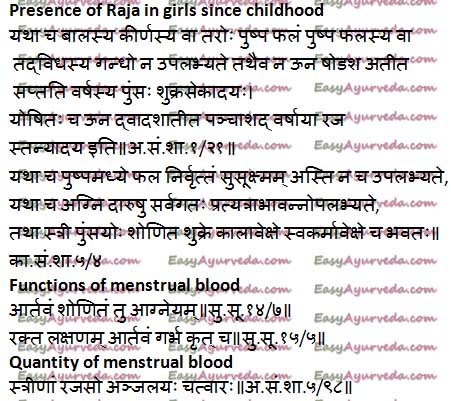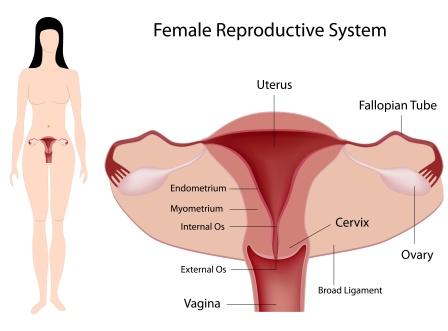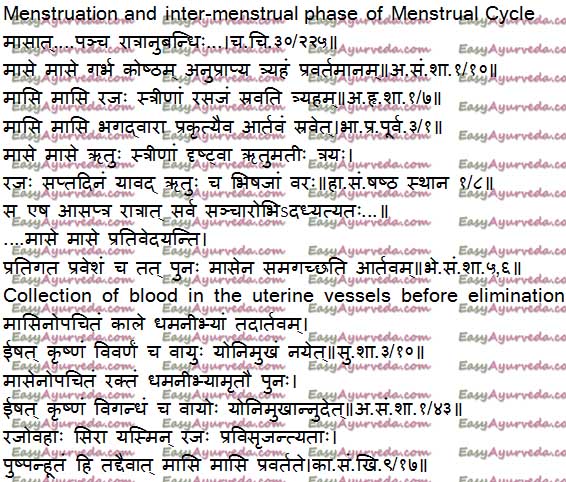Physiology Of Menstruation, Menstrual Cycle – Ayurvedic Perspective
By Dr Raghuram Y.S. MD (Ay) & Dr Manasa, B.A.M.S
Menstrual blood which flows out every month in women is called as Raja or Artava in Ayurveda.
Table of Contents
Introduction
Below mentioned terms are used to explain menstrual blood and also ovum in different contexts. These terms are interchangeable.
- Artava, Raja, Shonita, Asruk, Beeja
- Rakta, Lohita, Rudhira, Pushpa
Read – 10 Tips to Reduce The Risk of Breast Cancer
Extending or shortening menstrual cycle
Are there any remedies to extend or decrease menstrual cycles?
Dr JV Hebbar
I will explain two natural remedies to extend or to shorten periods cycle but before that –
This method is useful, but might not work as expected every time because, menstrual cycle is influenced by various factors such as mood (1), hormones, obesity (2), junk food, alcohol, smoking, sleeping late at night, nutrition status, etc. So, if you have a function to attend and want to extend the cycle, this may not work as expected all the time.
Ideal menstrual cycle length is 28-30 days. It may vary from 21-40 days in some people. In the early years after menarche and nearing menopause, there will be ups and downs.
The below technique may work when you have 25 days cycle and want to extend it a bit or if you have 35 days cycle and want to shorten a bit.
Shortening menstrual cycle:
10 days ahead of the expected cycle – consider doing one, two or all of the below.
a. Include 1 teaspoon of horse gram in diet, per day.
Read Horse Gram Uses, Recipes, Side Effects
In the morning, on an empty stomach, take 1 – 2 teaspoons of sesame seed powder along with a teaspoon of jaggery.
b. Papaya fruit is beneficial in inducing periods. She can have once per day.
c. Aloe Vera – regular usage – Aloe vera juice, Aloe vera Sabji (palya)
Extending the menstrual cycle:
Flaxseeds are known to extend the menstrual cycle. They have phyto-estrogens, which helps to reduce the effect of estrogen hormone produced by the body. A tablespoon of flaxseeds a day is known to delay menstrual cycle by one day.
Along with it, healthy number of rigorous exercises are also known to extend the periods (3)
Sanskrit verse

Physiology
Physiology of menstruation, menses – Ayurveda perspective
Presence of Raja or Shonita in girls since childhood
According to Karya Karana vada i.e., cause and effect relationship, nothing manifests newly.
If something needs to be manifest, it should have been present right from beginning and would manifest when appropriate time comes.
This means to tell that something which has been present right from beginning in hidden form itself will manifest when proper time comes. This theory is explained with respect to semen in case of men and menstrual blood or ovum in case of women.
According to ancient teachers of Ayurveda, semen in male and ovum in female would be present in a latent form right from childhood. They would only get manifest and are discharged when the person attains puberty.

Flowers and fruits do not come up in young or aged plants. Fragrance is not emitted by a bud or decaying flower. Similarly in males’ semen is not manifested before sixteen years of age and after seventy years of age. Likewise menstrual blood and breast milk do not get manifested before twelve years and after fifty years of age.
Read – Interrelationship Of Pelvic Organs As Explained By Sushruta
Fruit is situated within the flower in a latent form. It cannot be seen until it gets manifested. Similarly, fire is located in wood in a hidden form. It is not manifested without specific efforts being made. Similarly menstrual blood in females and semen in males require appropriate time just like some fruit to get manifested from a flower and specific effort just like fire to get manifested from the wood for them to appear grossly.
These two similes explain presence of menstrual blood in smaller proportions right from the beginning of a girl’s life, but only gets manifested at right time and with right efforts.
Formation of menstrual blood
Menstrual blood is an upadhatu i.e., byproduct of rasa dhatu. It is also called as Raja.
Related Reading – Upadhatu of Rasa Dhatu
Rasa dhatu forms blood tissue. During this process of transformation, a part of rasa forms menstrual blood as its byproduct. This menstrual blood reaches uterus and is discharged for three days, every month in women. This menstrual blood which gets expelled from the uterus / vagina every month is called artava.
Functions of Menstrual blood (Arthava)
- Menstrual blood is fiery in nature.
- It has characteristics of blood.
- Helps in formation of fetus.
- Essential for life
Menstrual blood is predominant in fire element. Other elements exist in minor proportions.
The reason being –
Sannidhya – proximity
Paraspara upakara- mutual coordination
Paraspara anupravesha – mutual entry of one atom into other atoms of elements of nature.
Quantity of Menstrual blood
Normal quantity in the body of a woman is 4 anjali i.e., 4 ounces approximately.
Read –Heavy Periods, Menstrual bleeding Ayurvedic Treatment
Menarche and Menopause
Appearance of first menstruation in girls is called menarche. This will be marked by appearance of secondary sexual characters.
Menopause means cessation of menstruation cycle in old, aged woman.
Secondary sexual characters appearing on menarche are –
- Manifestation of pubic and axillary hairs
- Menstruation
- Appearance of breast milk
- Development of breasts, uterus and vagina
Age of menarche and Menopause
Age of menarche and menopause are said to be 12 years and 50 years respectively.
Kashyapa has mentioned age of menarche as 16 years.
Arunadatta opines that age of menarche and menopause may change from woman to woman and doesn’t occur as a rule.
Read – Bone Mineral Density In Women: Staying Healthy With Strong Bones
Rutu Chakra – Menstrual Cycle
Rutu Chakra means menstrual cycle.
It is approximately of 28-30 days.
It appears for once in every month in a woman who has healthy reproductive system. It is marked by menstrual bleeding for 3-7 days.
Number of menstrual days differs from woman to woman.
Rutu kala extends from first day of one cycle to the first day of next cycle.
Read – Are You Suffering From These 18 Side Effects Of Pranayama? Solutions
Rtu chakra can be divided into three phases.
1.Raja Srava Kala –
This is menstruation phase during which bleeding from vagina takes place for 3-7 days.
The blood collected for whole month by both uterine blood vessels, having slight black color and specific odor is propelled downwards towards vaginal orifice for excretion. This happens due to action of vayu.
Normal menstrual blood is not contaminated by doshas, the normal menstruation involving such blood also happens once in a month, free from pain, burning sensation or slimy discharges, occurs for 5 days, occurs in normal proportions and has color of jequirity, lotus flower, lac or rabbit’s blood and doesn’t stain the clothes.
Read – Polycystic ovarian syndrome, obesity and insulin resistance – natural management
Ayurveda has explained certain restrictions to be followed during menstrual bleeding. This can be considered as earliest explanation of menstrual hygiene. Following these regulations and restrictions would keep her health in good terms. Likewise, it would be a preparation to conceive a healthy child if she is planning to conceive after cessation of bleeding during that cycle.
2.Rtukala – Rutu Kala,
Compared to the proliferative phase of menstrual cycle, which also includes ovulation time, is the appropriate time for conception.
As per Ayurveda, Rtukala is of 12 days according to some authors, and 16 days according to few.
authors. It starts from the 4th day of menstruation. The woman in rtukala is called as rtumati.
Read – Siravyadha Method Of Bloodletting: Procedure, Precautions, Benefits
3.Rtu Vyateeta Kala –
This starts from 17th day of menstrual cycle and ends before first day of next menstrual cycle. This is compared to secretory phase of menstrual cycle. We do not find straight reference to describe this phase, but inferences can be drawn from the explanation of yoni samvarana or closure of vagina and uterus for entry of sperms after 16th day.
Rutu Chakra – Menstrual Cycle, Ayurvedic Viewpoint
Menstrual cycle in a woman comprises period of approximately 28 days. It extends from the first day of one cycle to the first day of the next cycle. The number of days comprising of a menstrual cycle is variable in different women based on body constitution, hormonal disorders, diseases of reproductive system and many other causes including stress and lifestyle changes. It is also called as menstruation or monthly cycle or periods.
Read – Lifestyle Tips For Healthy People And Patients In Ayurveda
Menstrual cycle is the regular natural change that occurs in the female reproductive system that makes pregnancy possible.
The first period usually begins between 12 to 15 years of age and is known as menarche.
Typical length of time between the first day of one period and the first day of the next cycle is 21-45 days in young women and 21-35 days in adults.
The average length of the period is 28 days.
Menstruation stops after menopause which usually occurs between 45-55 years of age.
Bleeding in menstrual cycle lasts around 2-7 days.
Read – How To Improve Blood Circulation? 25 Ayurveda And Yoga Tips
The menstrual cycle is governed by hormonal changes. Each cycle is divided into 3 phases based on events.
in the ovary i.e., ovarian cycle
or in the uterus i.e., uterine cycle.
The ovarian cycle consists of the follicular phase, ovulation and luteal phase. The uterine cycle is divided into menstruation, proliferative phase and secretory phase.
Ayurveda has explained the menstrual cycle in detail. We can find the reference of the same in various treatises with slight change in opinions among the authors.
Read – Are You Suffering From These 18 Side Effects Of Pranayama? Solutions

Read – Types Of Pranayama – Effect on Health – Through An Ayurveda Microscope
Menstrual cycle
Rutuchakra – Menstrual Cycle from Ayurvedic viewpoint
The menstrual cycle in Ayurveda is called Rutu Chakra. We do not find the explanation of rutu chakra divided into phases as in modern texts but compiling the scattered references and aligning them we can divide the Rutuchakra into 3 stages from Ayurvedic viewpoint.
1 chandramasa or 1 lunar month of 28 days of rutuchakra of woman is divided into three phases depending upon the various changes taking place in the body of a woman during different time periods in the specified time. They are –
– Raja Srava Kala (menstruation) – 3-5 days
– Rutukala (proliferative phase including ovulation) – 12-16 days
– Rutu vyatitakala (post ovulatory period or secretory phase) – 9-13 days
Read –Hypomenorrhoea: Causes, Remedies, Ayurvedic Treatment
1. Raja Srava – Menstruation and inter-menstrual phase of Menstrual Cycle
There is a difference of opinion regarding the duration of bleeding among different authors.
– According to Vagbhata and Bhavamishra – 3 days
– According to Charaka – 5 days
– According to Harita and Bhela – 7 days
Bhavamishra has further elaborated saying that if the flow of blood is excessive, it lasts for 3 days, if it is average, it lasts for five days and if bleeding is slight in the absence of other disturbing symptoms of abnormality it may persist even up to 16 days.
When there are no pathological symptoms and if the periods are easy and if shuddha artava lakshanas i.e., symptoms of non-contaminated blood are available, all these conditions may be considered as normal.
On an average, the duration of menstruation may be taken as 3-5 days.
The intermenstrual period has been given as of one month by all the authors.
Read – Ayurvedic Ashwagandha Home Remedy For Conception For Women
Collection of blood in the uterine vessels before elimination
The blood collected for the whole month by both the uterine vessels and their endometrial capillaries, assuming slight black color and specific odor is brought down towards the vaginal orifice by the action of vayu for excretion.
According to Vishwamitra, hair thin vessels fill the uterus for whole month to receive the bija i.e., zygote.
This description indicates that the menstruation is a result of changes occurring in the vascular apparatus of uterus for the whole month or in other words, this refers to the cyclic changes occurring in the endometrium.
Read – Essential Elements For Conception – Garbha Sambhava Samagri
Characteristics of normal menstrual blood and menstruation
When the menstruation is normal and the menstrual blood is not contaminated by doshas, it gets discharged in one month, not associated with pain, burning sensation or slimy substances, bleeding occurs for 5 days, quantity of bleeding is neither too much nor too less. The blood has color of jequirity, or lotus flower or lac or blood of rabbit and doesn’t stain the cloth.
Mode of living during Menstruation
There are certain rules and regulations a woman has to follow during menstruation i.e. menstrual cycle. If the restrictions are not followed, she may have to suffer from many complications. Since Ayurveda has explained fertile period meant for conception (rutuchakra, rtukala) and rules to be followed during these periods in view of conception and begetting healthy child, it becomes important for the woman to follow proper regimen related to diet and lifestyle during menstrual and ovulation periods.
Read –Hypertension Causes, Types, Symptoms, Ayurvedic Treatment
Not following these restrictions also may cause harm to the child if the woman conceives. She may also give birth to child who will have many birth anomalies, low endurance, strength and stamina, sometimes the child may die in the womb or at birth.
Therefore, the woman has to follow these regulations and restrictions strictly.
Read – 40 Ways To Attain Salvation As Per Ayurveda – Nivrutti
2. Rtu kala – ovulation time, proliferative phase of menstrual cycle
Rutu Kala is the appropriate time for conception. It is compared to proliferative phase of the menstrual cycle. During this time ovulation takes place. According to Ayurveda it is said to be of 12 days. It starts from the 4th day of menstruation i.e., after the cessation of bleeding. Some authors also opined that it is of 16 days. The woman during this stage of menstrual cycle is called Ritumati.
Read – Monthly Development Of Fetus – Ayurvedic perspective
3. Rutu Vyateeta Kala – the secretory phase of menstrual cycle
Nothing much has been explained about this phase in Ayurvedic texts, but we can discuss about the knowledge of this phase of menstrual cycle by holding on to certain clues from the treatises.
Yoni Samvarana or closure and constriction of vagina so as to not allow the entry of sperms into the uterus has been mentioned in Ayurvedic texts as already discussed in Rutu Kala. If we take the Rutukala as twelve days after three days of menstruation, the closure of vagina takes place on the 16th day.
The inter-menstrual period is said to be one month in Ayurveda, roughly 28 days in modern medicine. So, the time period of menstrual cycle extending from 16th day to the beginning of the next menstrual cycle i.e., first day of bleeding in next cycle can be taken as Rutu ateeta kala or secretory phase of menstrual phase.
Click to Consult Dr Raghuram Y.S. MD (Ayu) – Email / Skype








